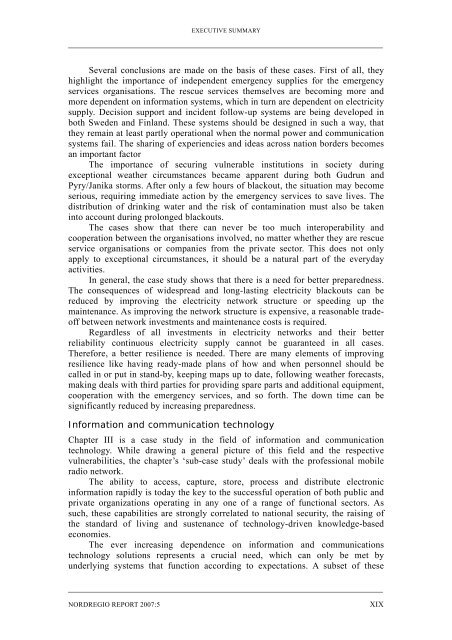Towards a Baltic Sea Region Strategy in Critical ... - Helsinki.fi
Towards a Baltic Sea Region Strategy in Critical ... - Helsinki.fi
Towards a Baltic Sea Region Strategy in Critical ... - Helsinki.fi
You also want an ePaper? Increase the reach of your titles
YUMPU automatically turns print PDFs into web optimized ePapers that Google loves.
EXECUTIVE SUMMARY<br />
Several conclusions are made on the basis of these cases. First of all, they<br />
highlight the importance of <strong>in</strong>dependent emergency supplies for the emergency<br />
services organisations. The rescue services themselves are becom<strong>in</strong>g more and<br />
more dependent on <strong>in</strong>formation systems, which <strong>in</strong> turn are dependent on electricity<br />
supply. Decision support and <strong>in</strong>cident follow-up systems are be<strong>in</strong>g developed <strong>in</strong><br />
both Sweden and F<strong>in</strong>land. These systems should be designed <strong>in</strong> such a way, that<br />
they rema<strong>in</strong> at least partly operational when the normal power and communication<br />
systems fail. The shar<strong>in</strong>g of experiencies and ideas across nation borders becomes<br />
an important factor<br />
The importance of secur<strong>in</strong>g vulnerable <strong>in</strong>stitutions <strong>in</strong> society dur<strong>in</strong>g<br />
exceptional weather circumstances became apparent dur<strong>in</strong>g both Gudrun and<br />
Pyry/Janika storms. After only a few hours of blackout, the situation may become<br />
serious, requir<strong>in</strong>g immediate action by the emergency services to save lives. The<br />
distribution of dr<strong>in</strong>k<strong>in</strong>g water and the risk of contam<strong>in</strong>ation must also be taken<br />
<strong>in</strong>to account dur<strong>in</strong>g prolonged blackouts.<br />
The cases show that there can never be too much <strong>in</strong>teroperability and<br />
cooperation between the organisations <strong>in</strong>volved, no matter whether they are rescue<br />
service organisations or companies from the private sector. This does not only<br />
apply to exceptional circumstances, it should be a natural part of the everyday<br />
activities.<br />
In general, the case study shows that there is a need for better preparedness.<br />
The consequences of widespread and long-last<strong>in</strong>g electricity blackouts can be<br />
reduced by improv<strong>in</strong>g the electricity network structure or speed<strong>in</strong>g up the<br />
ma<strong>in</strong>tenance. As improv<strong>in</strong>g the network structure is expensive, a reasonable tradeoff<br />
between network <strong>in</strong>vestments and ma<strong>in</strong>tenance costs is required.<br />
Regardless of all <strong>in</strong>vestments <strong>in</strong> electricity networks and their better<br />
reliability cont<strong>in</strong>uous electricity supply cannot be guaranteed <strong>in</strong> all cases.<br />
Therefore, a better resilience is needed. There are many elements of improv<strong>in</strong>g<br />
resilience like hav<strong>in</strong>g ready-made plans of how and when personnel should be<br />
called <strong>in</strong> or put <strong>in</strong> stand-by, keep<strong>in</strong>g maps up to date, follow<strong>in</strong>g weather forecasts,<br />
mak<strong>in</strong>g deals with third parties for provid<strong>in</strong>g spare parts and additional equipment,<br />
cooperation with the emergency services, and so forth. The down time can be<br />
signi<strong>fi</strong>cantly reduced by <strong>in</strong>creas<strong>in</strong>g preparedness.<br />
Information and communication technology<br />
Chapter III is a case study <strong>in</strong> the <strong>fi</strong>eld of <strong>in</strong>formation and communication<br />
technology. While draw<strong>in</strong>g a general picture of this <strong>fi</strong>eld and the respective<br />
vulnerabilities, the chapter’s ‘sub-case study’ deals with the professional mobile<br />
radio network.<br />
The ability to access, capture, store, process and distribute electronic<br />
<strong>in</strong>formation rapidly is today the key to the successful operation of both public and<br />
private organizations operat<strong>in</strong>g <strong>in</strong> any one of a range of functional sectors. As<br />
such, these capabilities are strongly correlated to national security, the rais<strong>in</strong>g of<br />
the standard of liv<strong>in</strong>g and sustenance of technology-driven knowledge-based<br />
economies.<br />
The ever <strong>in</strong>creas<strong>in</strong>g dependence on <strong>in</strong>formation and communications<br />
technology solutions represents a crucial need, which can only be met by<br />
underly<strong>in</strong>g systems that function accord<strong>in</strong>g to expectations. A subset of these<br />
NORDREGIO REPORT 2007:5<br />
XIX

















